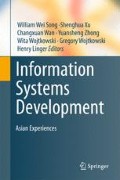Abstract
The majority of information systems change management guidelines and standards are either too abstract or too bureaucratic to be easily applicable in small enterprises. This chapter proposes the approach, the method, and the prototype that are designed especially for information systems change management in small and medium enterprises. The approach is based on proven patterns of changes in the set of information systems elements. The set of elements was obtained by theoretical analysis of information systems and business process definitions and enterprise architectures. The patterns were evolved from a number of information systems theories and tested in 48 information systems change management projects. The prototype presents and helps to handle three basic change patterns, which help to anticipate the overall scope of changes related to particular elementary changes in an enterprise information system. The use of prototype requires just basic knowledge in organizational business process and information management.
Access this chapter
Tax calculation will be finalised at checkout
Purchases are for personal use only
References
Robinson, P., Gout, FL.: Extreme Architecture Framework: A minimalist framework for modern times. In: Saha, P. (ed.) Handbook of Enterprise Systems Architecture in Practice, IGI Global, pp. 18–36 (2007).
Goikoetxea, A.: Enterprise Architecture and Digital Administration: Planning Design and Assessment. World Scientific Publishing Co. Pte. Ltd., Singapore (2007).
Harrington, H.J., Esselding, E.C., Nimwegen H.: Business Process Improvement. Workbook. Documentation, Analysis, Design and Management of Business Process Improvement. McGraw-Hill (1997).
Daoudi, F., Nurcan, S.: A Benchmarking Framework for Methods to Design Flexible Business Processes. In: Software Process Improvement and Practice, pp. 51–63 (2007).
Mumford, E.: Redesign Human Systems. Information Science Publishing, UK (2003).
Zacarias, M., Caetano, A., Magalhaes, R., Pinto, H.S., Tribolet, J.: Adding a human perspective to enterprise architectures. In: Proceedings of 18th International Workshop on Database and Expert Systems Applications, pp. 840–844 (2007).
Maddison, R., Dantron, G.: Information Systems in Organizations. Improving Business Processes. Chapman & Hall, London (1996).
Skalle, H., Ramachandran, S., Schuster, M., Szaloky, V., Antoun, S.: Aligning Business Process Management, Service-Oriented Architecture, and Lean Six Sigma for Real Business Results. IBM Redbooks (2009).
Spadoni, M., Abdomoleh, A.: Information Systems Architecture for business process modeling. In: Saha, P. (ed.) Handbook of Enterprise Systems Architecture in Practice, IGI Global, pp.366–380 (2007).
Alter, S.: Defining information systems as work systems: implications for the IS field. European Journal of Information Systems (2008) 17. Operational Research Society Ltd. pp. 448–469 (2008).
http://www.ibm.com/developerworks/library/ar-togaf1/#N10096.
Reference Model of Open Distributed Processing, http://en.wikipedia.org/wiki/RM-ODP.
Zachman, J.: A Framework for Information Systems Architecture. IBM Systems Journal, 26(3) (1987).
Extending the RUP with Zachman Framework, http://www.enterpriseunifiedprocess.com/essays/zachmanFramework.html.
DoD Architecture Framework. Version 1.5 Volume 2. Product Description. http://www.defenselink.mil/cio-nii/docs/DoDAF_Volume_II.pdf.
GERAM: Generalized Reference Architecture Enterprise and Methodology. Version 1.6.3. IFIP – IFAC Task Force on Architectures for Enterprise Integration. http://www.cit.gu.edu.au/~bernus/taskforce/geram/versions/geram1-6-3/v1.6.3.html.
Nazzal, D.: Reference Architecture for Enterprise Integration. CIMOSA GRAI/GIM PERA http://www2.isye.gatech.edu/~lfm/8851/EIRA.ppt#264,8,CIMOSAEnterprise.
Teng J.T., Grover V., Fiedler K.D.: Initiating and Implementing Business Process Change: Lessons Learned from Ten Years of Inquiry. In: T. Grover V., Kettinger W. (eds.): Process Think: Winning Perspectives For Business Change In The Information Age. Idea Group Publishing, UK, pp.73–114 (2000).
Theories Used in IS Research, available at http://www.fsc.yorku.ca/york/istheory/wiki/index.php/Main_Page.
Theory of administrative behavior, http://wwwfsc.yorku.ca/york/istheory/wiki/index.php/Administrative_behavior%2C_theory_of.
Organizational Knowledge creation theory, available at http://www.fsc.yorku.ca/york/istheory/wiki/index.php/Organizational_knowledge_creation.
Language action perspective, http://www.fsc.yorku.ca/york/istheory/wiki/index.php/Language_action_perspective.
Transactive memory theory http://www.fsc.yorku.ca/york/istheory/wiki/index.php/Transactive_memory_theory.
Knowledge-based theory of the firm http://www.fsc.yorku.ca/york/istheory/wiki/index.php/Knowledge-based_theory_of_the_firm.
Media richness theory, http://www.fsc.yorku.ca/york/istheory/wiki/index.php/Media_richness_theory.
Argumentation theory, http://www.fsc.yorku.ca/york/istheory/wiki/index.php/Argumentation_theory.
A Description of Toulmin’s Layout of Argumentation http://www.unl.edu/speech/comm109/Toulmin/layout.htm.
Cognitive fit theory, http://www.fsc.yorku.ca/york/istheory/wiki/index.php/Cognitive_fit_theory.
Transaction cost economics, http://www.fsc.yorku.ca/york/istheory/wiki/index.php/Transaction_cost_economics.
Kendall, M. G., Stuart A.: the Advanced Theory of Statistics. Interference and Relationship. Volume 2. Charles Griffin & Company Limited, London.
Author information
Authors and Affiliations
Corresponding author
Editor information
Editors and Affiliations
Rights and permissions
Copyright information
© 2011 Springer Science+Business Media, LLC
About this paper
Cite this paper
Makna, J., Kirikova, M. (2011). Patterns-Based IS Change Management in SMEs. In: Song, W., et al. Information Systems Development. Springer, New York, NY. https://doi.org/10.1007/978-1-4419-7355-9_5
Download citation
DOI: https://doi.org/10.1007/978-1-4419-7355-9_5
Published:
Publisher Name: Springer, New York, NY
Print ISBN: 978-1-4419-7205-7
Online ISBN: 978-1-4419-7355-9
eBook Packages: Computer ScienceComputer Science (R0)

